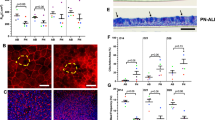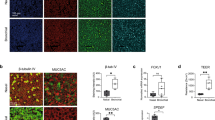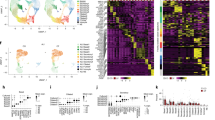Abstract
Targeted knockout of genes in primary human cells using CRISPR–Cas9-mediated genome-editing represents a powerful approach to study gene function and to discern molecular mechanisms underlying complex human diseases. We used lentiviral delivery of CRISPR–Cas9 machinery and conditional reprogramming culture methods to knockout the MUC18 gene in human primary nasal airway epithelial cells (AECs). Massively parallel sequencing technology was used to confirm that the genome of essentially all cells in the edited AEC populations contained coding region insertions and deletions (indels). Correspondingly, we found mRNA expression of MUC18 was greatly reduced and protein expression was absent. Characterization of MUC18 knockout cell populations stimulated with TLR2, 3 and 4 agonists revealed that IL-8 (a proinflammatory chemokine) responses of AECs were greatly reduced in the absence of functional MUC18 protein. Our results show the feasibility of CRISPR–Cas9-mediated gene knockouts in AEC culture (both submerged and polarized), and suggest a proinflammatory role for MUC18 in airway epithelial response to bacterial and viral stimuli.
This is a preview of subscription content, access via your institution
Access options
Subscribe to this journal
Receive 12 print issues and online access
$259.00 per year
only $21.58 per issue
Buy this article
- Purchase on Springer Link
- Instant access to full article PDF
Prices may be subject to local taxes which are calculated during checkout






Similar content being viewed by others
References
Berns K, Hijmans EM, Mullenders J, Brummelkamp TR, Velds A, Heimerikx M et al. A large-scale RNAi screen in human cells identifies new components of the p53 pathway. Nature 2004; 428: 431–437.
Jackson AL, Burchard J, Schelter J, Chau BN, Cleary M, Lim L et al. Widespread siRNA "off-target" transcript silencing mediated by seed region sequence complementarity. RNA 2006; 12: 1179–1187.
Mali P, Yang L, Esvelt KM, Aach J, Guell M, DiCarlo JE et al. RNA-guided human genome engineering via Cas9. Science 2013; 339: 823–826.
Shalem O, Sanjana NE, Hartenian E, Shi X, Scott DA, Mikkelsen TS et al. Genome-scale CRISPR-Cas9 knockout screening in human cells. Science 2014; 343: 84–87.
Wang T, Wei JJ, Sabatini DM, Lander ES . Genetic screens in human cells using the CRISPR-Cas9 system. Science 2014; 343: 80–84.
Platt RJ, Chen S, Zhou Y, Yim MJ, Swiech L, Kempton HR et al. CRISPR-Cas9 knockin mice for genome editing and cancer modeling. Cell 2014; 159: 440–455.
Xue W, Chen S, Yin H, Tammela T, Papagiannakopoulos T, Joshi NS et al. CRISPR-mediated direct mutation of cancer genes in the mouse liver. Nature 2014; 514: 380–384.
Yin H, Xue W, Chen S, Bogorad RL, Benedetti E, Grompe M et al. Genome editing with Cas9 in adult mice corrects a disease mutation and phenotype. Nat Biotechnol 2014; 32: 551–553.
Dekkers JF, Wiegerinck CL, de Jonge HR, Bronsveld I, Janssens HM, de Winter-de Groot KM et al. A functional CFTR assay using primary cystic fibrosis intestinal organoids. Nat Med 2013; 19: 939–945.
Jean D, Gershenwald JE, Huang S, Luca M, Hudson MJ, Tainsky MA et al. Loss of AP-2 results in up-regulation of MCAM/MUC18 and an increase in tumor growth and metastasis of human melanoma cells. J Biol Chem 1998; 273: 16501–16508.
Lehmann JM, Riethmuller G, Johnson JP . MUC18, a marker of tumor progression in human melanoma, shows sequence similarity to the neural cell adhesion molecules of the immunoglobulin superfamily. Proc Natl Acad Sci USA 1989; 86: 9891–9895.
Xie S, Luca M, Huang S, Gutman M, Reich R, Johnson JP et al. Expression of MCAM/MUC18 by human melanoma cells leads to increased tumor growth and metastasis. Cancer Res 1997; 57: 2295–2303.
Sers C, Kirsch K, Rothbacher U, Riethmuller G, Johnson JP . Genomic organization of the melanoma-associated glycoprotein MUC18: implications for the evolution of the immunoglobulin domains. Proc Natl Acad Sci USA 1993; 90: 8514–8518.
Johnson JP, Bar-Eli M, Jansen B, Markhof E . Melanoma progression-associated glycoprotein MUC18/MCAM mediates homotypic cell adhesion through interaction with a heterophilic ligand. Int J Cancer 1997; 73: 769–774.
Simon GC, Martin RJ, Smith S, Thaikoottathil J, Bowler RP, Barenkamp SJ et al. Up-regulation of MUC18 in airway epithelial cells by IL-13: implications in bacterial adherence. Am J Respir Cell Mol Biol 2011; 44: 606–613.
Wu Q, Case SR, Minor MN, Jiang D, Martin RJ, Bowler RP et al. A novel function of MUC18: amplification of lung inflammation during bacterial infection. Am J Pathol 2013; 182: 819–827.
Liu X, Ory V, Chapman S, Yuan H, Albanese C, Kallakury B et al. ROCK inhibitor and feeder cells induce the conditional reprogramming of epithelial cells. Am J Pathol 2012; 180: 599–607.
Suprynowicz FA, Upadhyay G, Krawczyk E, Kramer SC, Hebert JD, Liu X et al. Conditionally reprogrammed cells represent a stem-like state of adult epithelial cells. Proc Natl Acad Sci USA 2012; 109: 20035–20040.
Xie F, Ye L, Chang JC, Beyer AI, Wang J, Muench MO et al. Seamless gene correction of beta-thalassemia mutations in patient-specific iPSCs using CRISPR/Cas9 and piggyBac. Genome Res 2014; 24: 1526–1533.
Horani A, Nath A, Wasserman MG, Huang T, Brody SL . Rho-associated protein kinase inhibition enhances airway epithelial Basal-cell proliferation and lentivirus transduction. Am J Respir Cell Mol Biol 2013; 49: 341–347.
Chapman S, Liu X, Meyers C, Schlegel R, McBride AA . Human keratinocytes are efficiently immortalized by a Rho kinase inhibitor. J Clin Invest 2010; 120: 2619–2626.
Swiech L, Heidenreich M, Banerjee A, Habib N, Li Y, Trombetta J et al. In vivo interrogation of gene function in the mammalian brain using CRISPR-Cas9. Nat Biotechnol 2015; 33: 102–106.
Cheng R, Peng J, Yan Y, Cao P, Wang J, Qiu C et al. Efficient gene editing in adult mouse livers via adenoviral delivery of CRISPR/Cas9. FEBS Lett 2014; 588: 3954–3958.
Berman R, Huang C, Jiang D, Finigan JH, Wu Q, Chu HW . MUC18 differentially regulates pro-inflammatory and anti-viral responses in human airway epithelial cells. J Clin Cell Immunol 2014; 5: 257.
Poole A, Urbanek C, Eng C, Schageman J, Jacobson S, O'Connor BP et al. Dissecting childhood asthma with nasal transcriptomics distinguishes subphenotypes of disease. J Allergy Clin Immunol 2014; 133: 670–8 e12.
Thorvaldsdottir H, Robinson JT, Mesirov JP . Integrative Genomics Viewer (IGV): high-performance genomics data visualization and exploration. Brief Bioinform 2013; 14: 178–192.
Karp PH, Moninger TO, Weber SP, Nesselhauf TS, Launspach JL, Zabner J et al. An in vitro model of differentiated human airway epithelia. Methods for establishing primary cultures. Methods Mol Biol 2002; 188: 115–137.
Acknowledgements
This work was supported by R01 AI106287 and R01 HL122321 to HWC and NJH startup funds to MAS.
Author information
Authors and Affiliations
Corresponding author
Ethics declarations
Competing interests
The authors declare no conflict of interest.
Additional information
Supplementary Information accompanies this paper on Gene Therapy website
Supplementary information
Rights and permissions
About this article
Cite this article
Chu, H., Rios, C., Huang, C. et al. CRISPR–Cas9-mediated gene knockout in primary human airway epithelial cells reveals a proinflammatory role for MUC18. Gene Ther 22, 822–829 (2015). https://doi.org/10.1038/gt.2015.53
Received:
Revised:
Accepted:
Published:
Issue Date:
DOI: https://doi.org/10.1038/gt.2015.53
This article is cited by
-
Exosomes for CRISPR-Cas9 Delivery: The Cutting Edge in Genome Editing
Molecular Biotechnology (2023)
-
High rate of HDR in gene editing of p.(Thr158Met) MECP2 mutational hotspot
European Journal of Human Genetics (2020)
-
Conditionally Reprogrammed Human Normal Airway Epithelial Cells at ALI: A Physiological Model for Emerging Viruses
Virologica Sinica (2020)
-
CRISPR/Cas9-mediated knockout of NSD1 suppresses the hepatocellular carcinoma development via the NSD1/H3/Wnt10b signaling pathway
Journal of Experimental & Clinical Cancer Research (2019)
-
Organoid technology and applications in cancer research
Journal of Hematology & Oncology (2018)



